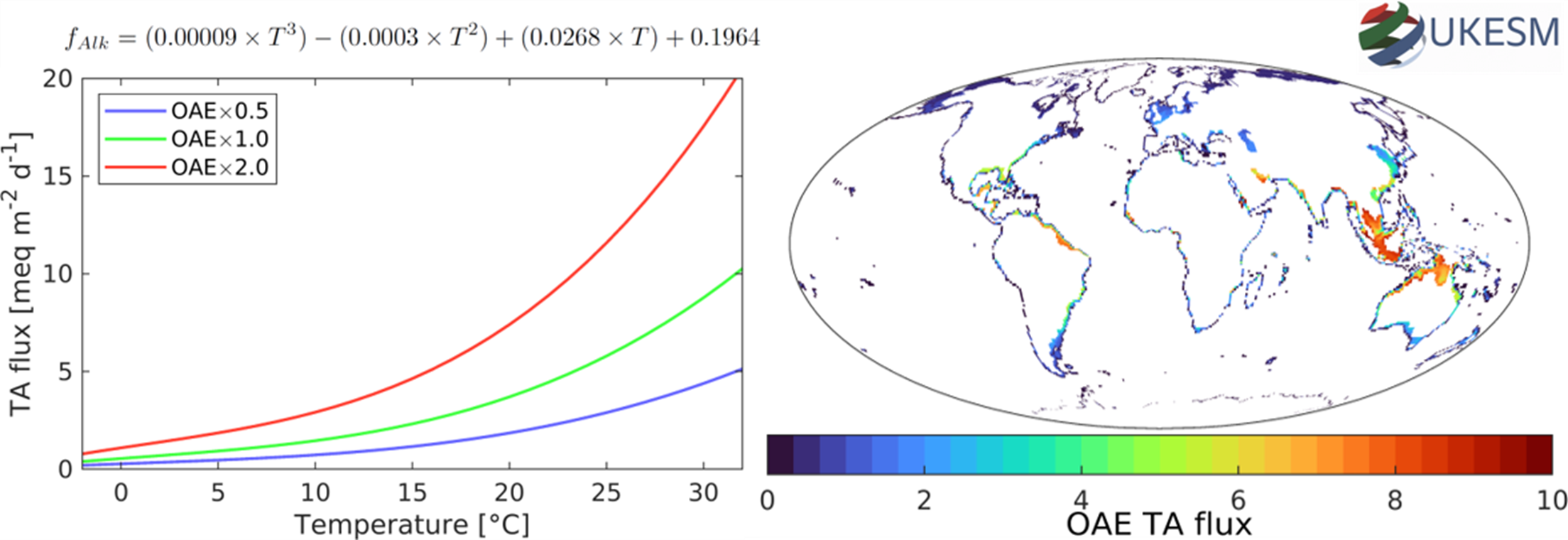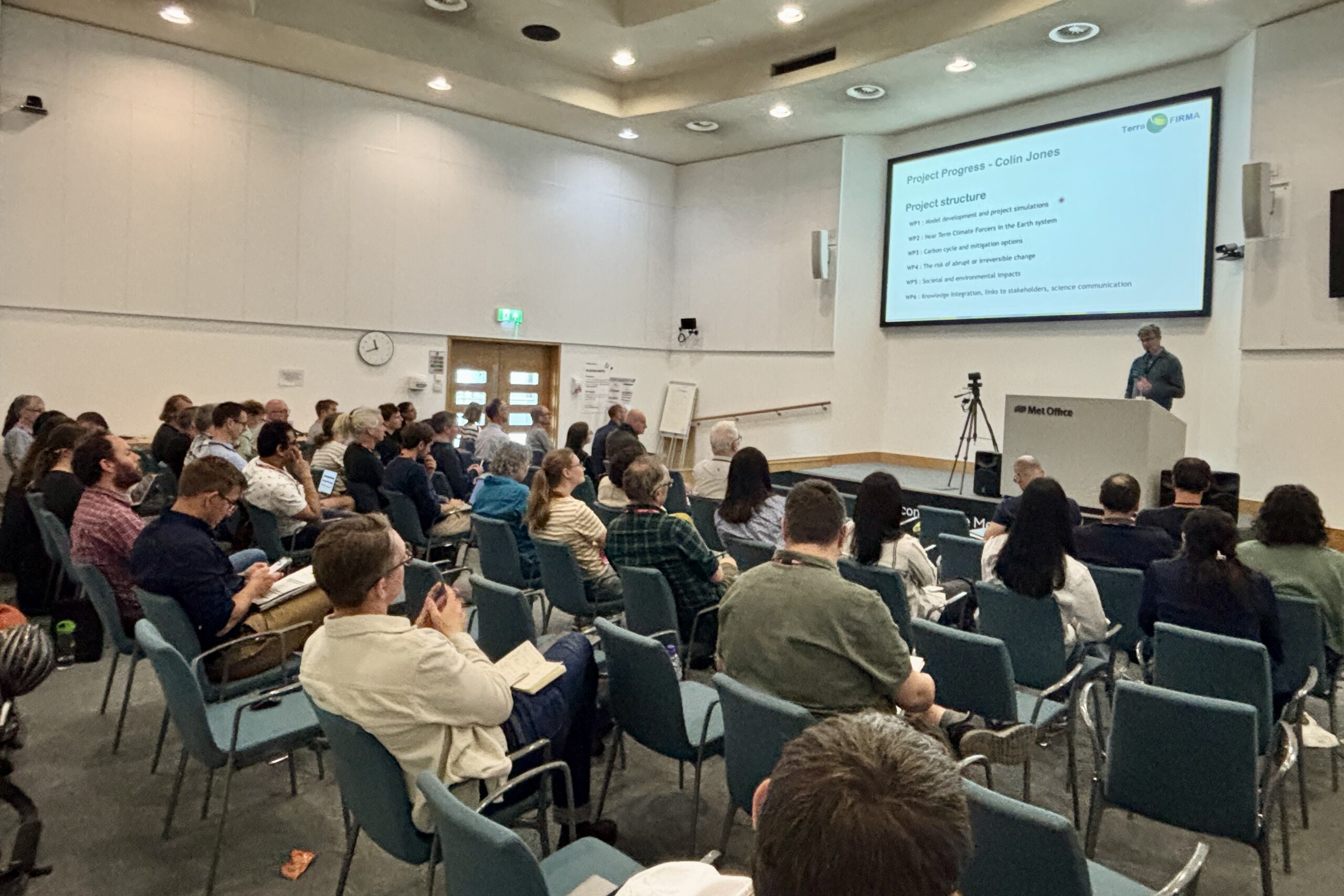News
Global-scale evaluation of a coastal ocean alkalinity enhancement (OAE) scheme in UKESM1
Andrew Yool and Julien Palmieri
National Oceanography Centre
The Earth’s climate is rapidly changing with an increase in mean surface air temperature of 1.09°C between 1850-1900 and 2011-2020. This is largely due to emissions of carbon dioxide (CO2) which have raised atmospheric CO2 from approximately 278 parts per million (ppm) prior to the Industrial Revolution to 417 ppm as of 2023. The Paris Agreement aims to limit global warming to well below the threshold of 2°C, ideally below a target of 1.5°C.
A key element to reach “net zero” by 2050 is the rapid reduction of CO2 emissions. However, it is unlikely the world will realize the scale of reductions required to reach net zero, meaning there will still be residual CO2 emissions and an overshoot of 1.5°C becomes very likely. Large-scale active CO2 removal (CDR) will likely be necessary to lower atmospheric CO2 concentrations and avoid extra warming. These CDR technologies range widely and may even involve the living systems of the land and ocean. An alternative is the ocean alkalinity enhancement (OAE) which instead focuses on modifying seawater chemistry to enhance its capacity to uptake and store CO2 on a long-term basis.
OAE is modelled on the Earth’s natural cycles of mineral weathering that act to absorb CO2. Minerals would be mined, ground into small particles and added to the ocean to dissolve and liberate alkalinity (ALK). This needs to happen at or near the ocean surface for the extra CO2 to be absorbed from the atmosphere. OAE has been assessed in national reviews as effective but with cost and infrastructure issues to be resolved, and it is also the focus of ongoing commercial and scientific trials (or attempted trials in the case of Cornwall). Potential issues associated with OAE include:
- The cost and CO2 emissions of continuous mineral mining, processing and transport to OAE locations;
- Difficulty in distributing and dissolving OAE minerals;
- Retention of dissolved ALK near the ocean’s surface so that atmospheric CO2 can be absorbed;
- “Side effects” on marine biogeochemistry and ecosystems.
As field trials are ongoing, and likely to continue as net zero targets come under increasing pressure, evaluation of such schemes is important to answer, “do they work?” and “what side effects are there?” questions.
One flavour of OAE uses olivine – (Mg,Fe)2SiO4 – a primary component of the Earth’s mantle, and one which naturally weathers relatively rapidly at the Earth’s surface. It has been proposed that olivine is added as sands in coastal waters, as these are more readily accessible than the open ocean and the shallow seabed ensures dissolved ALK remains in close contact with the atmosphere.
In the TerraFIRMA project, we have added a parameterisation of this proposed coastal addition to UKESM1. A temperature-dependent ALK addition equation is used where the seafloor is <= 100m, and the scheme rolled out continuously through 2020-2100 under a relatively high emissions scenario (SSP370) to evaluate its effect on carbon, climate, and the ocean’s living systems.
Figure 1: left – how simulated OAE addition varies with temperature (including lower and higher sensitivity tests); right – the location and magnitude of OAE addition in UKESM1 for the year 2020 in meq m−2 d−1.
Figure 1 shows this OAE addition equation, together with the resulting pattern of ALK added to the model ocean. ALK is added where the shallow shelf is large enough, and at greater rates in warmer waters – most obviously in the Indonesian Archipelago.
Figure 2: 21st century time series plots of: left – global surface ALK; middle – air-sea CO2 uptake; right – atmospheric CO2 concentration.
Figure 2 shows how OAE changes first the ocean’s surface ALK, then the air-sea CO2 flux, and finally the concentration of CO2 in the atmosphere. As the results show, ocean uptake of CO2 is increased as planned and does act to decrease the atmosphere’s CO2. However, the results also show that this latter change is relatively small compared to the impact of anthropogenic emissions in this particular future scenario (about 10 ppm compared to the control). This translates into a drop in global mean of surface air temperature of around -0.06°C by 2100, although this is well within the noise of the temperature increase between 2020-2100.
Figure 3: left – vertically-integrated added ALK; middle – vertically-integrated extra CO2 absorbed; right – a section around the World Ocean showing what depth the absorbed CO2 has reached.
Figure 3 shows first where the coastally-added ALK gets to by 2100, then where the extra CO2 absorbed reaches, and finally the distribution of the latter by depth around the whole ocean. As is clear from both geographical plots, although added at the coastal margins, the effect of OAE reaches well into the open ocean. The final panel shows that, although the OAE here is a shallow water process, the absorbed CO2 (and also the added ALK; not shown) gets into the deep ocean interior – particularly in regions like the high latitude North Atlantic, where cold and salty water sinks into its deep interior.
In conclusion, using a quite generous OAE experimental design (continuous addition of ALK at global scale for 80 years), we find a noticeable impact on CO2 air-sea flux, increasing the CO2 absorption rate by an extra ~0.5 Pg-C y-1 by 2100. Between 2020-2100, this integrates to a total of ~25 Pg-C removed from the atmosphere by the effect of the olivine dissolution – this is approximately the same as what is currently released into the atmosphere in ~2 years. However, the changes in atmospheric CO2 concentration and surface air temperature are more modest. Nonetheless, as part of a wider programme to achieve net zero, OAE potentially has a role to play.
Finally, in terms of what the simulated OAE requires, the amount of olivine needed for these results can be deduced from the total alkalinity added, and this corresponds to a minimum of 100 billion tons, which would require mining at a rate of about 300 times greater than currently. So, for this scheme to contribute towards the “negative emissions” needed for net zero, a significant increase in this industry would be required, and without causing emissions of its own.
This research is currently being written up as a peer-reviewed paper for submission in summer 2023.





